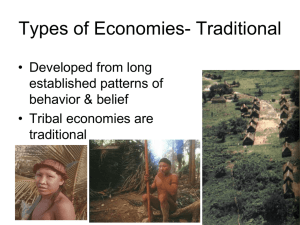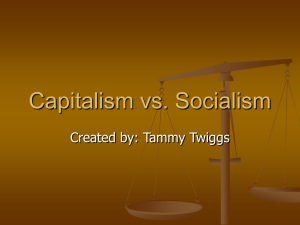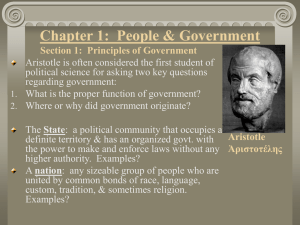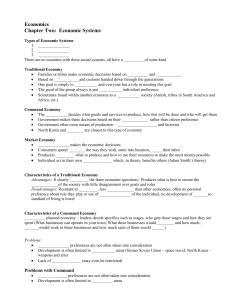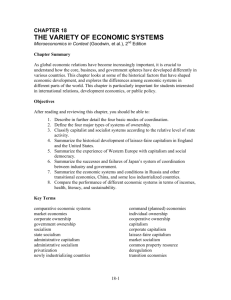Chapter 2.pptx
advertisement
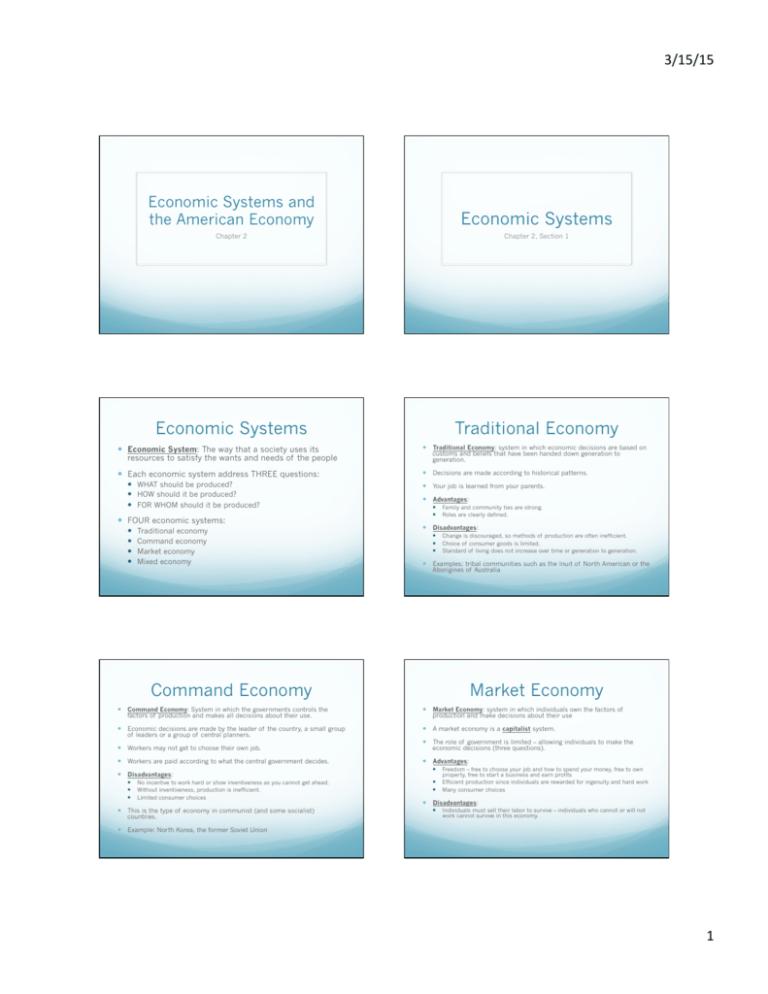
3/15/15 Economic Systems and the American Economy Economic Systems Chapter 2 Chapter 2, Section 1 Economic Systems Traditional Economy ! Economic System: The way that a society uses its ! Traditional Economy: system in which economic decisions are based on ! Each economic system address THREE questions: ! Decisions are made according to historical patterns. resources to satisfy the wants and needs of the people ! WHAT should be produced? ! HOW should it be produced? ! FOR WHOM should it be produced? ! FOUR economic systems: ! ! ! ! Traditional economy Command economy Market economy Mixed economy customs and beliefs that have been handed down generation to generation. ! Your job is learned from your parents. ! Advantages: ! Family and community ties are strong. ! Roles are clearly defined. ! Disadvantages: ! Change is discouraged, so methods of production are often inefficient. ! Choice of consumer goods is limited. ! Standard of living does not increase over time or generation to generation. ! Examples: tribal communities such as the Inuit of North American or the Aborigines of Australia Command Economy Market Economy ! Command Economy: System in which the governments controls the ! Market Economy: system in which individuals own the factors of ! Economic decisions are made by the leader of the country, a small group ! A market economy is a capitalist system. factors of production and makes all decisions about their use. of leaders or a group of central planners. ! Workers may not get to choose their own job. ! Workers are paid according to what the central government decides. ! Disadvantages: ! No incentive to work hard or show inventiveness as you cannot get ahead. ! Without inventiveness, production is inefficient. ! Limited consumer choices ! This is the type of economy in communist (and some socialist) countries. production and make decisions about their use ! The role of government is limited – allowing individuals to make the economic decisions (three questions). ! Advantages: ! Freedom – free to choose your job and how to spend your money, free to own property, free to start a business and earn profits ! Efficient production since individuals are rewarded for ingenuity and hard work ! Many consumer choices ! Disadvantages: ! Individuals must sell their labor to survive – individuals who cannot or will not work cannot survive in this economy. ! Example: North Korea, the former Soviet Union 1 3/15/15 Market Economy (continued) ! Market Economy: system in which individuals own the factors of production and make decisions about their use Market Economy (continued) ! Circular Flow of Income and Output: economic model that pictures income as flowing continuously between businesses and consumers ! Market: The process of freely exchanging goods and services between buyers and sellers. ! This exchange is driven by prices. ! This is the opposite of a command economy. ! Example: There are no pure market economies. The US is primarily a market economy but not purely. Mixed Economy ! Mixed Economy: system combining characteristics of more than one type of economy. ! Most mixed economies are a combination of command and market economies. ! Private ownership of property and individual decision making are combined with government intervention and regulation. ! Examples of government involvement in mixed economies: Characteristics of the American Economy Chapter 2, Section 2 ! Government consumes and produces goods (military, roads, schools) ! Government may own some factors of production (such as natural resources) ! Transfer programs – taking taxes from some citizens and giving the money to the poor, elderly or disabled (welfare, medicaid) ! Example: The US is a mixed economy – it is a combination of market and command economies The Limited Role of Government in the American Economy ! America is capitalist – an economic system in which private individuals own the factors of production. ! Laissez-faire: a French term “let the people do as they choose” It refers to a pure capitalist system. ! In America, individuals own the factors of production but use them within certain legislated limits. ! The role of the government in our economy is limited but has grown over Characteristics of the American Economy ! Limited Role of Government ! Freedom of Enterprise – Individuals are free to own the factors of production and decide how to use them within legal limits. ! Free-enterprise system = capitalism = market economy ! Freedom of Choice – Buyers decide what will be produced based on buying or not buying a certain product. the last 100 years. ! Federal agencies regulate the quality of food and drugs ! Federal government oversees the nation’s banking system ! Government inspects workplaces for hazardous conditions ! Government guards against damage to the environment ! Government uses tax revenues to provide social programs to the elderly, poor ! Profit Incentive – The desire to make a profit that motivates ! ! Private Property – Property can be owned by individuals or and disabled State and local governments regulate education people to produce goods and services. ! Profit: Business revenues minus costs ! Competition – rivalry among producers of similar goods and services to win more business. groups of individuals rather than by the government. 2 3/15/15 Remember… Free-Enterprise System = Capitalism = Market Economy Goals of a Nation Chapter 2, Section 3 Goals of Free-Enterprise ! Freedom – Individuals have choices: what to buy, what to produce, what to own, what to do for a living, how much to work. ! With freedom come costs – if you start a business that fails, the government usually won’t help you. ! Economic Efficiency – wise use of scarce resources to obtain the greatest possible benefit ! If we waste resources, we won’t have as many goods. ! Economic Equity – the attempt to balance economic policy so that everyone benefits fairly. ! Equal pay for equal work, fairness in hiring ! The US is a technically a mixed economy but it is much more market economy and less command economy Goals of Free-Enterprise (continued)… ! Economic Stability – reducing extreme ups and down in our standard of living: material well-being of a person, group or nation measured by how well their necessities and luxuries are satisfied. ! Economic Growth – expansion of the economy to produce more goods, jobs and wealth. ! Economic Security – protection against risks beyond our control (accident at work, bank failure, natural disasters, poverty in old age) Rights and Responsibilities in Free Enterprise Rights Responsibilities ! Enter any profession or ! Support yourself and your ! Work very little or even be ! Use you education to ! Buy whatever products and ! Elect responsible business you choose a “workaholic” brands you choose family become a productive member of society Socialism and Capitalism Chapter 2, Section 4 government officials – this means having knowledge of government policies and being able to analyze those policies 3 3/15/15 Socialism Socialism ! Pure Command Socialism: a system in which the government owns the major factors of production and attempts to manage output and the distribution of goods ! There are few examples of this: North Korea and Cuba and the former Soviet Union ! Marxian View of Socialism: Marx’s view is that capitalists (owners of businesses) exploit workers. He believed that since the workers made the goods, the workers should get the profits, not the owners. ! Marx believed that capitalism would make the workers poor and the workers would rise up and overthrow capitalism. Then the government would own the factors of production, creating socialism. ! Marx also believed that socialism would evolve into communism: an idealized society where there is no government; “society” not individuals would own the factors of production. ! This exists nowhere today ! In reality, communist countries have very powerful central governments, not “no government”. Socialism In the 20th Criticisms of Socialism century, two types of socialism developed: ! Democratic Socialism: system that works within a constitutional framework of a nation to elect socialists to office; the government usually controls only some areas of the economy. ! Many countries have this system. ! Government interference in the economy ! Limited personal freedoms ! Low production efficiency ! Slow rate of economic growth ! Authoritarian Socialism: system that supports revolution as a means to overthrow capitalism and bring about socialist goals. The entire economy is controlled by a central government – also called communism. ! Examples: North Korea, Cuba, the former Soviet Union. Capitalism Benefits ! Freedom ! Better efficiency ! Higher rates of economic growth Criticisms ! Not all people have the same income level ! Government does not provide enough services for people ! Planning is shared by individuals, businesses and government 4


